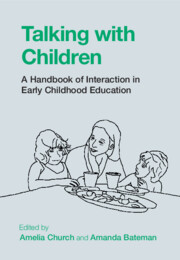Book contents
- Talking with Children
- Talking with Children
- Copyright page
- Dedication
- Contents
- Figures
- Tables
- Contributors
- Acknowledgements
- Notes on Transcription Conventions
- Introduction
- Part I Talk as Social Action
- Part II Pedagogy in Interaction
- Part III Interaction and Inclusion
- 15 Play
- 16 Mental Health and Wellbeing
- 17 Neurodiversity
- 18 Friendships
- 19 Conflict
- 20 Morality
- 21 Families
- Index
- References
18 - Friendships
from Part III - Interaction and Inclusion
Published online by Cambridge University Press: 16 June 2022
- Talking with Children
- Talking with Children
- Copyright page
- Dedication
- Contents
- Figures
- Tables
- Contributors
- Acknowledgements
- Notes on Transcription Conventions
- Introduction
- Part I Talk as Social Action
- Part II Pedagogy in Interaction
- Part III Interaction and Inclusion
- 15 Play
- 16 Mental Health and Wellbeing
- 17 Neurodiversity
- 18 Friendships
- 19 Conflict
- 20 Morality
- 21 Families
- Index
- References
Summary
Responsive and respectful relationships are principal elements of early childhood curricula in many countries. Children seek to interact with peers, be included as part of a group, and make friends. Successful relationships in the early years lead to better communication skills, increased general knowledge, and feelings of wellbeing, all necessary for successful life and work outcomes. Making friends is often viewed as a ‘natural’ state of childhood, and consequently, assumes an individual’s social skills are the sole reason for a child’s ability to make friends or not. This chapter takes an interactional view to show that friendships are linked to ongoing and inter-dependent actions of the peer group. Seven examples of peer interactions highlight the ways in which children actively seek to participate and build friendships. It is these ‘implications for practice’ that demonstrate how early childhood educators might support children’s play and participation so as to develop responsive and respectful relationships. The chapter argues that when an interactional process approach, based on conversation analysis is adopted, educators can identify the criticality of the social context, and best support children’s opportunities to be included and make friends.
Keywords
- Type
- Chapter
- Information
- Talking with ChildrenA Handbook of Interaction in Early Childhood Education, pp. 368 - 387Publisher: Cambridge University PressPrint publication year: 2022
References
- 3
- Cited by

